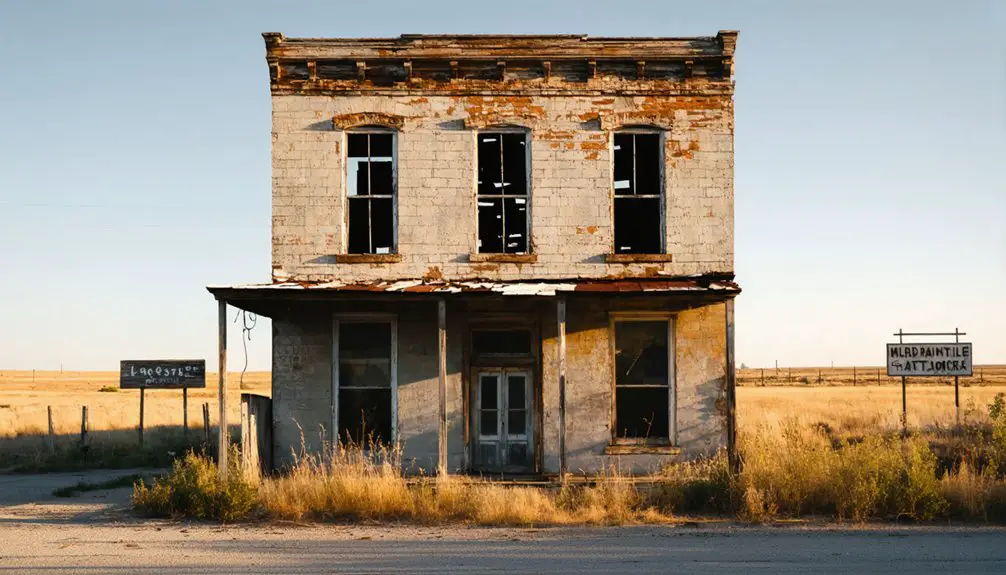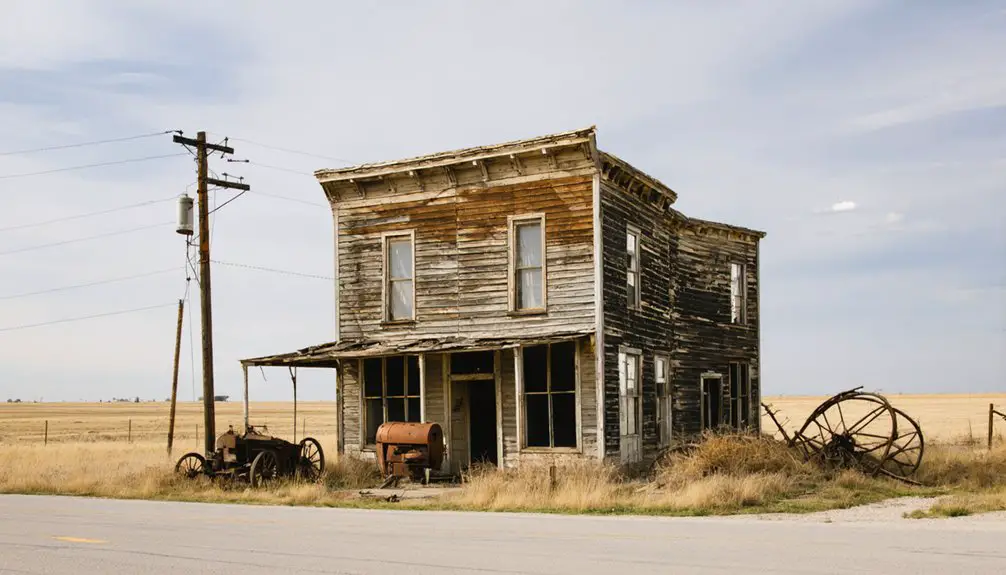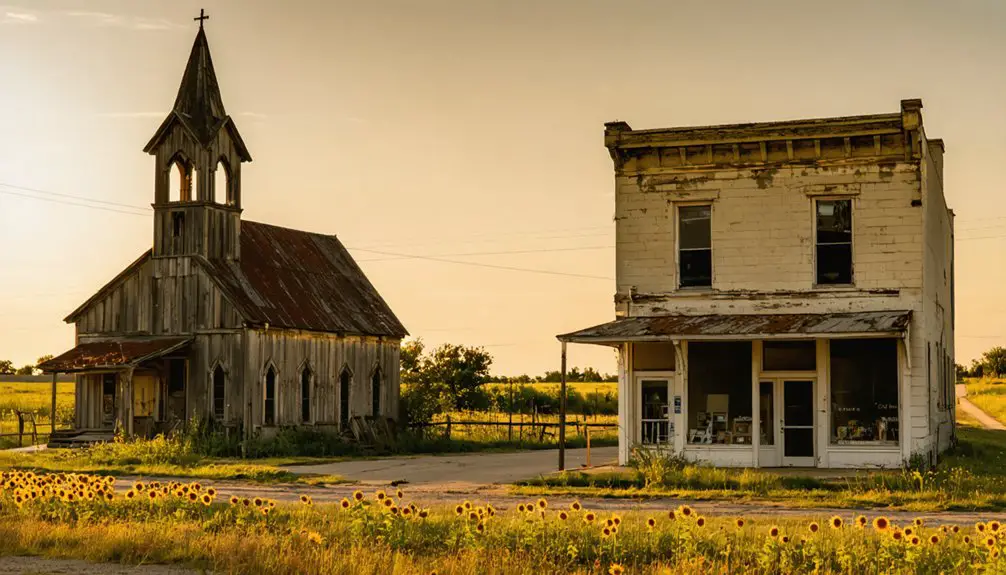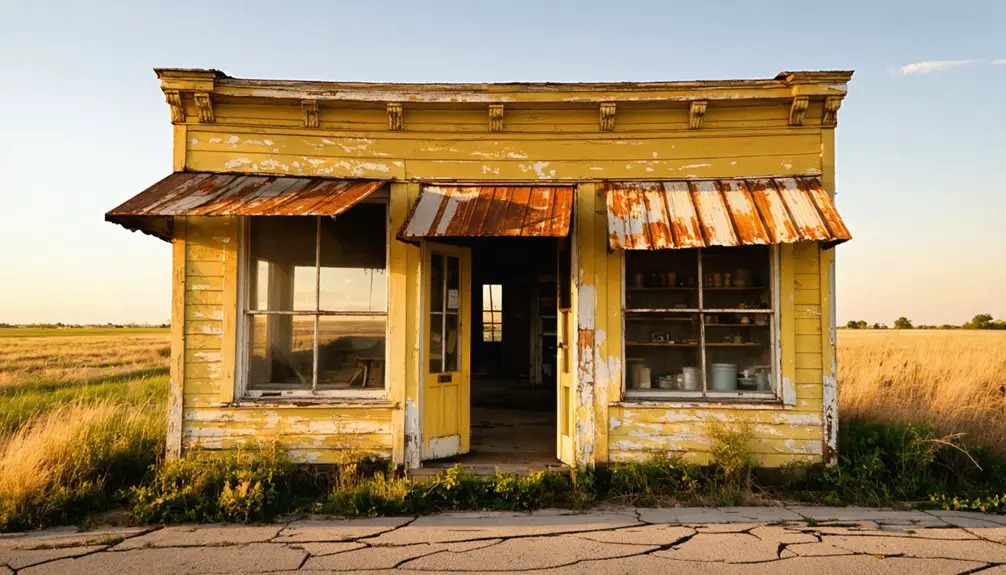You’ll find Idavale’s remains in south-central Kansas’s Kiowa County at 37.8°N, 99.2°W, where it emerged as an agricultural settlement in the 1870s. The town thrived briefly with its Southern Kansas Railway connection, general store, and grain elevators serving pioneer farmers. Environmental challenges, including devastating tornadoes and the 1930s Dust Bowl, combined with declining rail traffic, led to its abandonment. Today, a 1947 church, cemetery, and scattered agricultural buildings trace this lost community’s story.
Key Takeaways
- Idavale was established in the 1870s as an agricultural settlement in south-central Kansas’s Kiowa County, supported by the Southern Kansas Railway.
- The town’s economic decline began with reduced railway traffic and transportation changes that drew commerce away from local businesses.
- Environmental challenges, including tornadoes and the 1930s Dust Bowl, devastated crops and caused significant economic hardship for residents.
- The combination of agricultural difficulties, transportation changes, and economic downturn eventually led to Idavale’s abandonment as a viable community.
- Today, only a church, cemetery, and scattered agricultural buildings remain, with the oldest surviving structure dating to 1947.
The Rise and Fall of Idavale
While many Kansas towns flourished during the late 19th century’s westward expansion, Idavale emerged as a modest agricultural settlement with basic amenities including a general store, post office, and blacksmith shop. Like many mining communities of the era, inhabitants focused on limited leisure activities with only baseball and music to pass the time.
Like countless frontier settlements, Idavale began humbly with only essential services to support local farming families.
You’ll find its story mirrors countless other ghost towns across Kansas, where dreams of prosperity collided with harsh realities. Without vital railroad connections, Idavale couldn’t compete with neighboring towns that enjoyed direct access to larger markets. Towns like Home City thrived with railroad access, becoming major agricultural shipping hubs.
Natural disasters, including tornadoes and devastating droughts, repeatedly struck the vulnerable community. By the early 1900s, you’d have witnessed the town’s steady rural decline as younger residents sought opportunities elsewhere.
Agricultural mechanization and dwindling population ultimately sealed Idavale’s fate, and by mid-century, it had joined the ranks of Kansas’s abandoned settlements.
Location and Geographic Features
Located in south-central Kansas’s Kiowa County, Idavale’s abandoned remains sit at approximately 37.8°N latitude and 99.2°W longitude within the vast expanse of the Great Plains.
You’ll find the ghost town south of Greensburg, nestled in a landscape characterized by gently rolling plains at an elevation between 2,200 and 2,400 feet above sea level.
The surrounding landscape characteristics reflect the region’s agricultural heritage, with loamy soils that once supported dryland farming of wheat, corn, and sorghum. Much like the German region of Waldeck and Pyrmont, the area’s rich agricultural traditions have shaped its development over generations.
You’ll notice the absence of forests, as native prairie grasses dominate the terrain. While county roads and gravel paths now provide the only access to this remote location, agricultural practices continue in the surrounding farmlands, where scattered ranches and wheat fields stretch across the wind-swept plains.
Early Settlement and Pioneer Life
As Kansas opened its frontier lands for settlement in the 1870s, pioneer families from eastern states and Canada established Idavale’s first homesteads, bringing with them dreams of agricultural prosperity.
You’d find these early settlers living in simple log structures that often doubled as businesses, with some families sharing living spaces due to limited infrastructure. Similar to early settlements like Columbia, Kansas, these structures included a log store, blacksmith shop, and several dwellings.
Despite pioneer hardships like harsh weather, isolation, and inadequate healthcare, community resilience shaped Idavale’s early days.
The pioneer spirit thrived through adversity, as settlers banded together to overcome isolation and hardship in building their new community.
You’ll note how settlers created a self-reliant hub centered around essential services – a post office operated from private homes, a blacksmith shop, and a general store.
Following the example of Bell Plane, settlers acquired land from the government for a dollar per acre, allowing families to establish permanent farms and homesteads.
Families worked together, farming the land and trading goods while facing the challenges of limited resources and difficult travel to larger towns for supplies.
Economic Activities and Development
You’ll find that Idavale’s early economic fortunes were closely tied to the Southern Kansas Railway, which facilitated trade and livestock shipping through the region.
Local business ventures emerged to support the railway operations and cattle trade, providing essential services to railway workers, ranchers, and travelers passing through the settlement. Like many agricultural communities, local establishments included grain elevators that served the area’s farmers. Similar to towns like Elmdale, the impact of natural disasters contributed to population loss and business closures.
The town’s eventual decline paralleled the reduction in railway traffic and the broader shift away from rail-dependent commerce in rural Kansas communities.
Railroad Growth and Decline
During Kansas’s post-Civil War era, railroad expansion transformed Idavale’s economic prospects through ambitious westward construction that began in Topeka in October 1868.
You’d have witnessed rapid development as railroads pushed toward western Kansas, following the Santa Fe Trail along the Arkansas River’s north bank. By 1872, the line had reached Dodge City and continued to the state’s western border. Santa Fe Railroad Company helped settlers establish new communities by providing incentives to relocate to Southwest Kansas.
The economic integration of remote areas like Idavale depended heavily on these rail connections. The completion of rail lines faced setbacks during the Panic of 1873, which triggered a widespread financial depression.
You could’ve bought land for just one-tenth the price of eastern Kansas properties, while the railroads transported essential goods like coal, building materials, and agricultural products.
Without rail access, the land held little value, but once tracks arrived, communities flourished through regular passenger service and freight shipments of cream, mail, and farm products.
Early Business Ventures
While rail connections fueled Idavale’s growth, the town’s early business ventures reflected the diverse economic needs of frontier Kansas settlements.
You’d have found a bustling main street lined with essential businesses, including a general store stocking farming supplies and household goods. The local blacksmith shop served the community’s agricultural innovations, keeping crucial farm equipment in working order.
Though mining ventures weren’t prominent in Idavale, the town’s economy thrived on agricultural production and livestock trading. A flour mill processed grain from nearby farms, while a dairy processing facility produced butter and cheese for local markets. Like Waco’s role as a shipping point, Idavale became an important hub for transporting agricultural products to wider markets.
These businesses formed the backbone of Idavale’s economy, supporting both the town’s residents and surrounding farming operations.
Social Life and Community Infrastructure

As with many Kansas ghost towns of its era, Idavale’s social fabric centered around key community institutions that defined daily life in the early 1900s.
You’d have found the school, church, and post office serving as primary gathering spots where residents maintained their local traditions and social bonds.
Like other small Kansas towns, community gatherings often revolved around cooperative farming activities and events at these central locations.
The town supported basic amenities including a general store and other small businesses that provided both services and social spaces.
While detailed records of Idavale’s specific institutions are limited, the pattern of social life likely mirrored that of similar rural Kansas communities, where churches and schools remained active until declining populations forced their closure in the mid-1900s.
Environmental Challenges and Natural Disasters
Kansas’s notorious weather patterns posed significant challenges to Idavale’s early settlers, with tornadoes striking the region repeatedly in the late 1800s and causing widespread destruction of buildings, crops, and essential infrastructure.
You’ll find that these devastating storms often hit multiple Kansas towns on the same day, mirroring the destruction seen in nearby Irving during the 1879 tornadoes.
The combination of severe weather events and the harsh conditions of the 1930s Dust Bowl created an increasingly difficult environment for maintaining a viable farming community in Idavale.
Weather’s Impact on Settlement
Throughout central Kansas’s settlement period, extreme and unpredictable weather patterns created substantial challenges for pioneers attempting to establish permanent communities like Idavale.
You’d face blistering summers above 90°F and brutal winters below 0°F, making year-round survival a constant struggle. Agricultural challenges proved especially formidable, as the region’s 25-35 inches of annual rainfall couldn’t be counted on when you needed it most.
Late spring frosts and early fall freezes limited your growing season, while sudden hailstorms could destroy your crops in minutes. Water resources were particularly unreliable, with wells running dry during droughts and streams becoming inconsistent.
Heavy snowfalls would isolate your community for days, while ice storms damaged buildings and disrupted essential supply routes.
Dust Bowl’s Devastating Effects
When the Dust Bowl struck Idavale in the 1930s, it delivered a devastating combination of ecological and economic catastrophes that would reshape the region’s future.
You’d have witnessed your neighbors’ fields turn barren as the native grasses disappeared, leaving topsoil exposed to fierce winds. The resulting dust storms brought both economic hardship and severe health risks, with many residents developing dust pneumonia and respiratory ailments.
As crop yields plummeted by over 25%, farming families faced tough choices about staying or abandoning their land.
- Black clouds of dust rolling across the prairie like thunderheads
- Fine soil particles coating everything inside homes, despite sealed windows
- Children wearing wet cloth masks while walking to school
- Dead livestock with lungs clogged by dirt and sand
Causes of Abandonment

Multiple interrelated factors contributed to Idavale’s abandonment, ranging from dramatic shifts in transportation infrastructure to devastating environmental disasters.
You’ll find that transportation changes played a significant role in the town’s abandonment factors, as improved highways and interstates drew residents away from local businesses. When people could travel longer distances for goods and services, Idavale’s commercial base eroded.
The 1930s Dust Bowl delivered another devastating blow, making farming unsustainable and triggering significant population shifts. Like many Kansas towns of its era, Idavale’s fate was sealed by this perfect storm of challenges.
Without rail access to sustain commerce and faced with severe agricultural decline, the community couldn’t maintain its population. The environmental catastrophe of the Dust Bowl ultimately accelerated the town’s transformation into a ghost town.
Remaining Structures and Historical Sites
Despite years of abandonment, several notable structures remain in Idavale that offer glimpses into its past. You’ll find a church standing as one of the key remaining landmarks, accompanied by its adjacent cemetery that holds the stories of former residents.
The oldest surviving structure dates to 1947, while scattered agricultural buildings on the outskirts continue to serve farming operations. Though the railroad’s physical presence has largely vanished, its former right-of-way still marks where commerce once flowed through town.
- The church cemetery features historic tombstones that chronicle the community’s timeline
- Agricultural structures dot the landscape, preserving the area’s rural character
- Railroad infrastructure remnants trace the town’s commercial lifeline
- Natural reclamation has overtaken most street layouts, though their patterns remain visible
Historical Legacy and Cultural Significance

As a demonstration of Kansas’s complex frontier history, Idavale’s legacy reflects broader patterns of economic boom and bust that shaped the American Midwest.
You’ll find its story intertwined with the region’s cultural heritage, from railroad-driven development to agricultural challenges that tested community resilience.
Like many Kansas ghost towns, Idavale’s significance extends beyond its physical remains. It’s part of a larger narrative that includes the dramatic social transformations of post-Civil War Kansas, where towns rose and fell based on political alignments, economic forces, and environmental pressures.
Today, Idavale serves as a symbol of the pioneering spirit that drove settlement across Kansas, while also highlighting how vulnerable these communities were to changes in transportation routes, market forces, and natural disasters.
Frequently Asked Questions
Are There Any Known Paranormal Activities Reported in Idavale?
Like a whisper in empty halls, you won’t find documented ghost sightings or haunted locations in Idavale. The available records don’t reveal any paranormal activity reports from this quiet Kansas town.
What Traditional Native American Tribes Originally Inhabited the Idavale Area?
You’ll find the Kansa (Kaw) people were the primary inhabitants of this region, with their tribal history centered along the Kansas River valley. The Osage also held cultural significance in surrounding territories.
Did Any Famous Historical Figures Ever Visit Idavale?
You won’t find evidence of any famous visitors to Idavale. Available historical records and Kansas archives don’t show any historical significance related to renowned figures stopping in this small farming community.
What Modern-Day Private Properties Now Occupy the Former Town Site?
You’ll find working farms and ranch properties owned by current landowners on private agricultural land, with no nearby attractions or public access to what was once Idavale’s bustling streets.
Were There Any Significant Archaeological Discoveries Made in Idavale?
You won’t find documented archaeological artifacts from formal excavations in this location. While historic preservation efforts exist in Clark County, there’s no evidence of significant discoveries specific to Idavale.
References
- https://www.youtube.com/watch?v=iB5rHT14eVI
- https://www.hhhistory.com/2019/05/ghost-towns-of-kansas.html
- https://www.youtube.com/watch?v=OyBXD18P_j4
- https://en.wikipedia.org/wiki/List_of_ghost_towns_in_Kansas
- https://thewanderingpigeon.com/2015/10/03/day-of-kansas-ghost-towns/
- https://www.humanitieskansas.org/get-involved/kansas-stories/places/mining-for-stories-in-a-kansas-ghost-town
- https://www.youtube.com/watch?v=VPZtNoncnig
- https://en.wikipedia.org/wiki/Waldeck
- https://en.wikipedia.org/wiki/Quickville
- https://dianastaresinicdeane.wordpress.com/2012/01/29/columbia-a-kansas-ghost-town-story/



